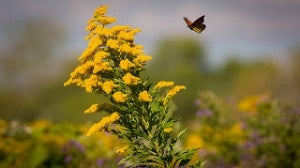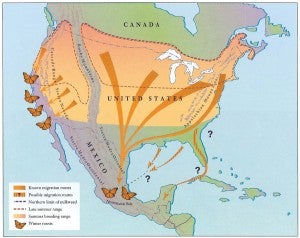
With help from farmers, the monarch butterfly will not go extinct
A report released yesterday in the journal Scientific Reports found “substantial probability” that the eastern population of monarch butterfly could be wiped out in a “quasi-extinction” event in the next two decades.
The study attributed the increased likelihood of an extinction event to extreme weather, which has historically posed a threat to monarch populations. But the study also noted that the most recent declines have been primarily caused by the eradication of milkweed from farms in the United States.
Despite the results of this report, I am convinced that we can save the monarch.
That’s because all of the pieces will soon be in place to reverse habitat loss and make recovery a reality.
A marketplace for monarch restoration

The Scientific Reports study states that efforts to recover the eastern monarch population should focus on the creation and restoration of breeding habitat. Of course, the big challenge is the sheer volume of habitat needed to achieve and sustain the population, which covers a large portion of North America, from Mexico to Canada.
To achieve the scale and pace of conservation needed, EDF is working with partners in agriculture, academia, industry and conservation to design an incentives-based program that can quickly restore milkweed to a broad swath of American farmland.
The program, called the Monarch Butterfly Habitat Exchange, uses an advanced habitat accounting method to measure habitat improvements and assign credit values to those improvements. This allows landowners the opportunity to get paid for maintaining and creating monarch habitat – a concept that has proven to be effective at engaging landowners in conservation.

Since farmers and ranchers manage much of the habitat appropriate for milkweed, they are critical participants in the exchange, having the ability to create key patches and corridors of breeding and nectaring habitats along the monarch butterfly’s great migration route.
Investors needed
All that’s needed now are major near-team investments to kick start this monarch marketplace.
We have had overwhelmingly positive responses from landowners who are eager to participate in the habitat exchange. But they need the financial assistance to adopt practices that help the monarch. These include avoiding the conversion of marginal lands to cropland and planting milkweed and nectar plants in roadsides and field edges.
With the right investments to bring these practices to scale across America’s monarch migratory pathway, I am confident that we can greatly reduce the chances of extinction and put the monarch on a path to recovery.
Related:
Butterfly numbers may be up, but they still need our help >>
My life’s work: Building strategies for ag and industry to protect wildlife >>
From California to Idaho: Protecting rural pit stops on the monarch butterfly’s great migration >>












